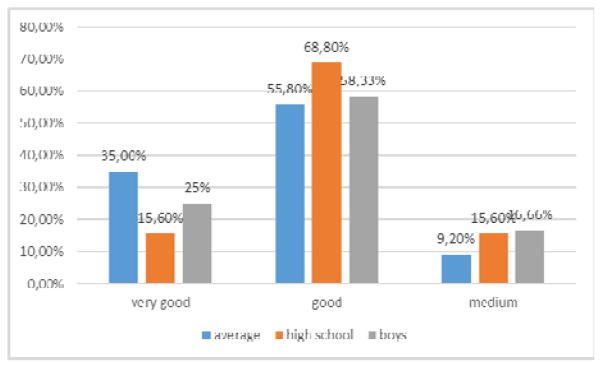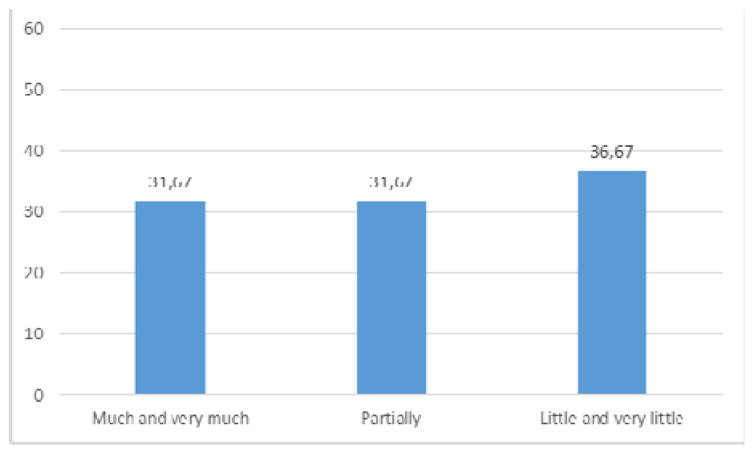Abstract
ASPIRA smoking prevention online program consists in studying five modules that include tests, videos and interactive games. It was tested on a group of schoolchildren and students from Tîrgu Mureş by completing a questionnaire with reference to the opinions of the young people and the functionality of the software. The vast majority of those questioned reported a good or very good impression about the ASPIRA program and believed that the information presented was suitable. High school pupils and boys were more critical.
Keywords: smoking prevention, ASPIRA online program, pilot study
INTRODUCTION
Although the harmful effects of smoking are well-known, smoking in Europe reaches around two thousand cigarettes/ person/ year, while statistics are unfavorable for women and youth (1, 2).
The Global Youth Tobacco Survey (GYTS) study was conducted in Romania in 2004 and 2009 and in other states of the European Union (3). The international study was conducted on children and young people. A recent local study shows that the mean age at which smoking is experimented is 11.7 years (4).
Educational institutions offer the most promising framework for measures to prevent and stop smoking in young age groups. Due to the lifestyle of young people, taking into account the changes in ways of communication, based on the existing technical and information equipment in schools, computer-assisted software has become increasingly popular. Recently, different types of online smoking prevention software have appeared which can be translated and applied (5). However, the design of such software requires the involvement of a multidisciplinary team (6).
Computer-assisted preventive software has the following advantages: it can reach more people, it provides a relative anonymity, individual information is submitted, and costs are relatively low compared with efficiency. The appearance of similar types of software can be seen in various medical fields (7, 8).
PURPOSE
In October 2012, The University of Medicine and Pharmacy of Tîrgu Mureş in cooperation with Davidson University in the United States launched a project entitled “Developing research capacity in the field of smoking in Romania”, funded by the Fogarty Foundation and National Institutes of Health, research project number R01TW009280 (9).
Using the ASPIRA online software, a subproject aims at investigating smoking in 9th graders attending high schools in Tîrgu Mureş. This paper presents the results and conclusions of the pilot test.
METHODS
The school Action Software to Prevent Interactive Smoking in RomaniA (ASPIRA) was done in Romanian and Hungarian by a whole team of researchers, programming experts, translators, and technicians. The adaptation was based on the software developed by a team of specialists at MD Anderson Cancer Center, Houston, USA (10, 11), according to the protocol of cooperation signed between the two parties. After an activity of nearly two years, multimedia (video, animations, interactive educational games) were translated and adapted to local cultural requirements, and were given controlled access on the website: http://aspira.umftgm.ro.
It is the first implemented computer-assisted methodology providing a wide target audience, and attractive content and format to students familiar with information and communication technology.
Before conducting the research proper and before completing the five modules which include tests, videos, and interactive games, ASPIRA was studied by researchers and experts, the proposed amendments being considered in order to finalize the software. A pilot test followed which surveyed a group of students: 84 girls and 36 boys, and 32 pupils and 88 medical students. The participants completed a questionnaire with reference to the views of young people, the operability of the software, and perception of barriers of language and culture. The ratios were calculated and graphs were created in Open Office Calc version 4.1.1.
RESULTS
The vast majority of the respondents (90.8%) had a good or very good opinion about ASPIRA. Depending on the school and gender, the general impression was less favorable in high school pupils and in boys: 15.6–16.6% with an average opinion (Figure 1).
Figure 1.
Overall impression about ASPIRA software according to gender and school
The analysis of the special feeling of the respondents revealed that 85.8% were satisfied with the videos, 84.2% with the interactive tests, and 80% with the interactive games, 15.8% of these reporting that they did not realize what they were supposed to do. Almost every fourth person found that there were some parts which seemed too long (23.3%).
It appears that to a little extent, the understanding of the messages was hampered by the fact that the people in the videos speak English: 15.8% partially, and 7.5% much and very much. Half of the young people (50.8%) felt that the translation and subtitles in their mother tongue helped very much or much better to understand the message, while every fourth person stated that they did not need a translation (25.8%). The vast majority (82.9%) of the subjects felt the pace/ speed of the display of subtitles was right, they could follow the text effortlessly. Only a small proportion of subjects could not follow the full captions despite their extra effort.
As far as barriers of language and culture are concerned, the best divided answers were to the question: To what extent would replacing persons and characters speaking in English with characters who speak Romanian/ Hungarian make the program easier to follow? About a third of the respondents thought that replacing foreign characters with local ones would greatly facilitate understanding the program, one third thought that it would partially facilitate its understanding, and a third that it would facilitate understanding it a little or very little (Figure 2).
Figure 2.
Opinions about replacing English-speaking people and characters in order to facilitate understanding
Only 7.5% of those participating in the pilot test of ASPIRA noted items that did not fit the culture and mentality of our country. Some said that “Young people in America are more direct and have other perceptions, thus they are not representative of the situation in our country.”
Two thirds (65.2%) considered that the information provided was suitable for 9th grade pupils, maintaining their attention and interest. While watching, 12.5% observed some technical errors or functionality problems. The majority (56.6%) believed that offering some raffle prizes would greatly motivate students to participate more seriously.
DISCUSSIONS
Nowadays antismoking policy puts great emphasis on smoking prevention (12, 13). One important strategic priority is reducing smoking among young people (14, 15).
As English seems to be a language spoken by many adolescents and young people both globally and in the Romanian society, new perspectives for prevention open up in the future (16). Simultaneously, experiences of computer-assisted software are growing (17). As difficulties in understanding messages in English decrease and as young people have increasingly wider access to the Internet, cultural differences become less important mentality.
If the conditions are ensured, various computer-assisted software developed by other researchers may be applicable to local conditions by adapting their translation. There is a wide range between testing and retesting of a questionnaire used to track smoking habits and attitudes and the adaptation of online software to prevent smoking (11, 18).
Pilot testing and consideration of the views of the interviewees is absolutely necessary in such situations.
CONCLUSIONS
Nowadays the focus is on the prevention of smoking and smoking cessation, which justifies the expansion and acceleration of research, prevention, and control on smoking. Among the methods applied in the future, an increasing importance will be played by computer-assisted software for preventing smoking and smoking cessation.
The expressed opinions show that the vast majority of the young people interviewed have a good or very good impression about the ASPIRA online software, and for the majority of participants in the pilot test the language and cultural barrier was not an important obstacle in understanding the messages transmitted by the tested software.
We can conclude that high school pupils and the boys were more critical, freely expressing opinions about the software. The findings and suggestions were considered by the researchers with a view to improving and completing the ASPIRA online software.
Acknowledgments
Research reported in this publication was supported by the Fogarty International Center and NCI of the National Institutes of Health under Award Number R01 TW09280.
Footnotes
The content is solely the responsibility of the authors and does not necessarily represent the official views of the National Institutes of Health.
References
- 1.United Nations. Global Health Observatory (GHO), Country Statistics. World Health Organization; 2012. [Google Scholar]
- 2.Anuar Statistic 2011. Institutul Naţional de Statistică; 2013. [Google Scholar]
- 3.Irimie S, et al. Tobacco Use among students from Romania 2004 versus 2009 GYTS data. Applied Medical Informatics. 2010;27:55–61. [Google Scholar]
- 4.Szabó B, Albert-Lőrincz E, Albert-Lőrincz M, Barna G, Bernáth K. Ábrám: Smoking behavior and possible intervention method among Romanian adolescents. Conference Proceedings, vol. II, International Multidisciplinary Scientific on Social Sciences and Arts; 2014; pp. 785–790. [Google Scholar]
- 5.Prokhorov AV, Fouladi R, de Moor C, Warneke CL, Luca M, Mullin Jones M, Rosenblum C, Emmons KM, Hudmon KS, Gritz ER. Computer-assisted, counselor-delivered smoking cessation counseling for community college students: Intervention approach and sample characteristics. J Child Adolesc Subst Abuse. 2007;16(3):35–62. [Google Scholar]
- 6.Tsoh JY, Kohn MA, Gerbert B. Promoting smoking cessation in pregnancy with Video Doctor plus provider cueing: a randomized trial. Acta Obstetricia et Gynecologica Scandinavica. 2010;89(4):515–523. doi: 10.3109/00016341003678419. [DOI] [PMC free article] [PubMed] [Google Scholar]
- 7.Khan MA, Shah S, Grudzien A, et al. A diabetes education multimedia program in the waiting room setting. Diabetes Therapy. 2011;2(3):178–188. doi: 10.1007/s13300-011-0007-y. [DOI] [PMC free article] [PubMed] [Google Scholar]
- 8.Arora M, Gerbert B, Potter MB, Gildengorin G, Walsh JME. PreView: Development and Pilot Testing of an Interactive Video Doctor Plus Provider Alert to Increase Cancer Screening. ISRN Preventive Medicine; 2013. Article ID 935487 http://www.hindawi.com/journals/isrn/2013/935487/ [DOI] [PMC free article] [PubMed] [Google Scholar]
- 9.Ábrám Z, Nădăşan V, Tarcea M, Kikeli P, Albert-Lőrincz E, Szabó Á, Schmidt L, Foley K. Building capacity for tobacco research in Romania. Acta Medica Marisiensis. 2012;58(3):33. [Google Scholar]
- 10.Prokhorov AV, Kelder SH, Shegog R, Murray N, Peters R, Agurcia-Parker C, Cinciripini PM, de Moor C, Conroy JL, Hudmon KS, Ford KH, Marani S. Impact of A Smoking Prevention Interactive Experience (ASPIRE), an interactive, multimedia smoking prevention and cessation curriculum for culturally diverse high-school students. Nicotine Tob Res. 2008;10(9):1477–1485. doi: 10.1080/14622200802323183. [DOI] [PubMed] [Google Scholar]
- 11.Prokhorov AV, Kelder SH, Shegog R, Conroy JL, Murray N, Peters R, Cinciripini PM, De Moor C, Hudmon KS, Ford KH. Project ASPIRE: an Interactive, Multimedia Smoking Prevention and Cessation curriculum for culturally diverse high school students. Subst Use Misuse. 2010;45(6):983–1006. doi: 10.3109/10826080903038050. [DOI] [PubMed] [Google Scholar]
- 12.WHO Report on the Global Tobacco Epidemic, 2008: The MPOWER package. Geneva: World Health Organization; 2008. [Google Scholar]
- 13.Fumatul şi sănătatea. Comportamente şi atitudini. Institutul Român pentru Evaluare şi Strategie; 2011. [Google Scholar]
- 14.Preventing tobacco use among youth and young adults : a report of the Surgeon General. Dept. of Health and Human Services, Centers for Disease Control and Prevention, National Center for Chronic Disease Prevention and Health Promotion, Office on Smoking and Health; Washington, D.C: 2012. pp. 3–8. [Google Scholar]
- 15.Eureka Strategic Research. Youth tobacco prevention literature review. Australian Government Department of Health and Ageing; 2005. pp. 36–91. [Google Scholar]
- 16.Oswald FL, Plonsky L. Meta-analysis in second language research: Choices and challenges. Annual Review of Applied Linguistics. 2010;30:85–110. [Google Scholar]
- 17.Grgurovic M, Chapelle CA, Shelley MC. A meta-analysis of effectiveness studies on computer technology-supported language learning. ReCALL. 2013;25:165–198. [Google Scholar]
- 18.Urbán R, Sutfin E. Do Early Smoking Experiences Count in Development of Smoking?: Temporal Stability and Predictive Validity of an Early Smoking Experience Questionnaire in Adolescents. Nicotine Tob Res. 2010;12(12):1265–1269. doi: 10.1093/ntr/ntq178. [DOI] [PMC free article] [PubMed] [Google Scholar]




